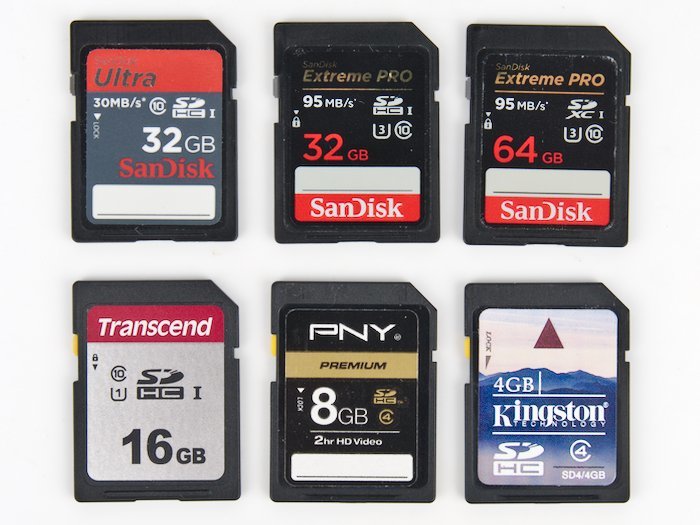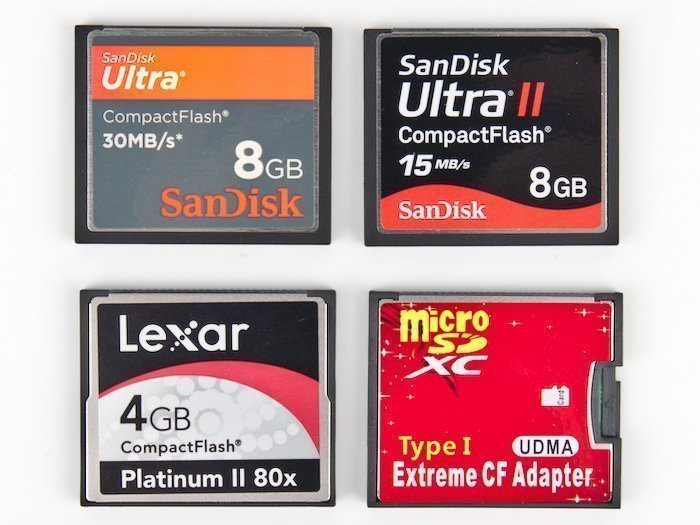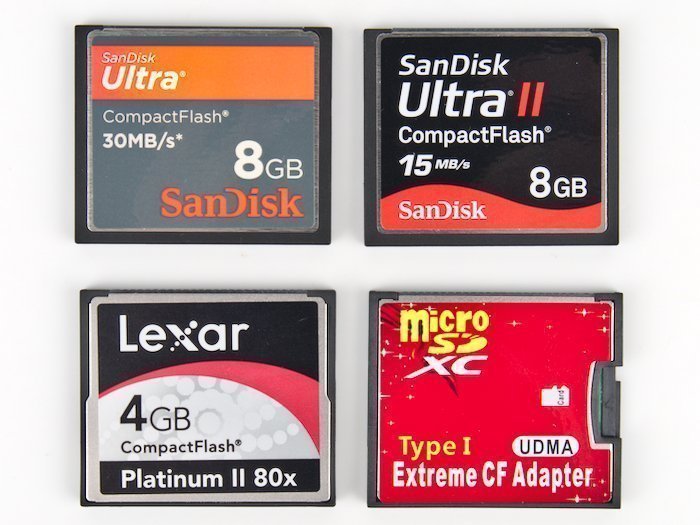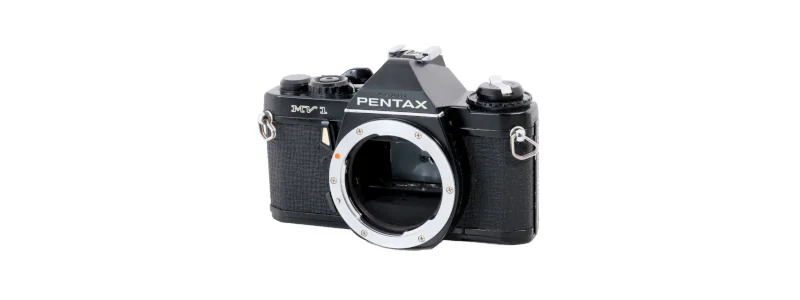
5 Excellent Pentax MV1 Lenses
- Nathaniel Stephan
- Pentax mv1
- October 26, 2022
Table of Contents
The Pentax MV1 is a great 35mm SLR camera. This post will cover the 5 best lenses for the Pentax MV1, plus a small number of alternative options.
Affiliate Advertising Disclosure
Outside the Shot is a participant in the Amazon Services LLC Associates Program, an affiliate advertising program designed to provide a means for sites to earn advertising fees by advertising and linking to Amazon.com.
As an eBay Partner, I may be compensated if you make a purchase. I also participate in affiliate advertising programs with KEH and Adorama. More can be found on the Affiliate Disclosure page.
In a hurry? The following is the list of the best lenses for the MV1:
- Kit Lens - SMC Pentax-M 50mm f/1.7
- Wide Angle Lens - SMC Pentax-M 28mm f/2.8
- Portrait Lens - SMC Pentax 135mm f/2.5
- Zoom Lens - Vivitar Series 1 28-90mm f/2.8-3.5
- Macro Lens - SMC Pentax 100mm f/4 Macro
The best Pentax K mount lenses are categorized by price range and type of photography. There are a number appropriate alternatives to pick that are in price ranges matching the value of the camera.
What Lens Mount Does the Pentax MV1 Use?
The Pentax MV1 has a Pentax K lens mount.
Introduced in 1975, the Pentax K mount is still being used in cameras. It replaced the M42 screw mount Which was used on cameras such as the Asahi Pentax Spotmatic. Over time improvements have been made to add metering information, autofocus, electronically controlled apertures, and CPU contacts.
As long as a lens has a physical aperture ring, it will be compatible with Pentax film cameras. Keep in mind, it isn’t a good idea to spend money on pricey features that will not be able to be used by the camera. The exception would be if you also own and use Pentax DSLRs.
It is also possible to use the older M42 mount lenses by using an adapter. People like to do this as some of the M42 mount Takumar lenses are spectacular. Even so, I would not encourage doing this as getting them without tight focus rings can be difficult.
Pentax-M vs Pentax-A
Pentax-M and SMC Pentax lenses have a a stop-down coupler that is built with a mechanical linkage to the camera. The stop-down coupler will allow the camera to know what the aperture is set to so the light meter can meter accurately without being required to use stop-down metering.
The Pentax-A series added the feature for the camera to set the aperture in the lens. Which means cameras that are compatible with the Pentax-A changes have the capability to do aperture priority and shutter priority modes.
Having said that, as that feature is not compatible with the camera, it does not make sense to spend money on features the camera is not able to use.
Standard Lens Cap and Filter Size
The standard lens cap and filter ring thread diameter used on most manual focus Pentax K mount lenses is 49mm. Lenses were originally sold with slip on caps, not the more typically used center-pinch type today. If you look at what is available, you’ll find only a few lenses sold with matching lens caps.
Be aware that big front elements will need to use larger caps and filters.
The advantage of using a standard thread size is that you only need to own a single set of filters.
Standard Focal Length Lenses
Here’s a range of 50mm focal lengths that can be used with the MV1. At the time when the camera was available for sale as new, there would’ve been a offer available to buy a 50mm lens with the camera as a kit.
The 50mm is called a standard lens due to the fact that the angle of view is similar to what people see with their eyes.
SMC Pentax-M 50mm f/1.7
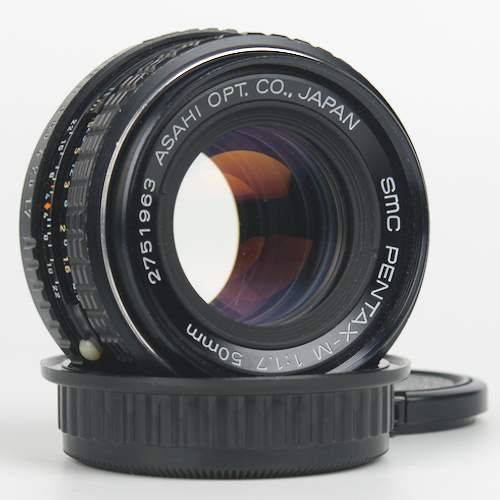
- “Kit” lens for the MV1.
- Great value.
- Light, small, and compact.
- 49mm filter threads.
See current price and more information on:
If you don’t currently own it, a really good initial lens to acquire is the SMC Pentax-M 50mm f/1.7. The 50mm f1.7 is easy to find, has very good image quality, is affordable, compact, and light . More images have been taken with this lens when compared to all other lenses.
{You can also get the next version, the SMC Pentax-A 50mm f/1.7|The 2nd version, the SMC Pentax-A 50mm f/1.7, is also a good buy}.
SMC Pentax-M 50mm f/1.4
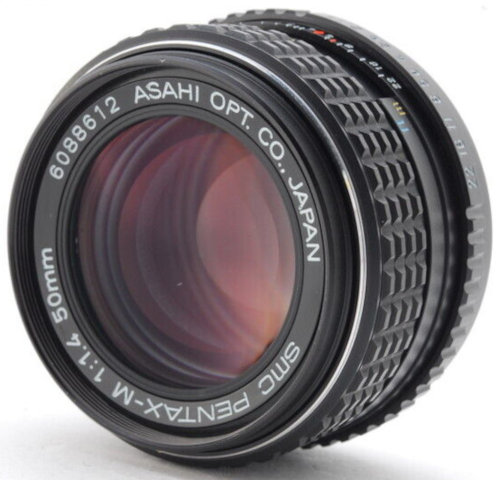
- Exceptional optics.
- Optical multi-coatings to improve output.
- Easy to find.
- Comparatively economical.
See current price and more information on:
The SMC Pentax-M 50mm f/1.4 is almost a stop faster than the f/1.7, at the added burden of additional size and weight. Expect to pay more than you would for an f/1.7 or f/2 lens. The next version, the SMC Pentax-A, and prior version, SMC Pentax, will both work with the MV1.
SMC Pentax 50mm f/1.2
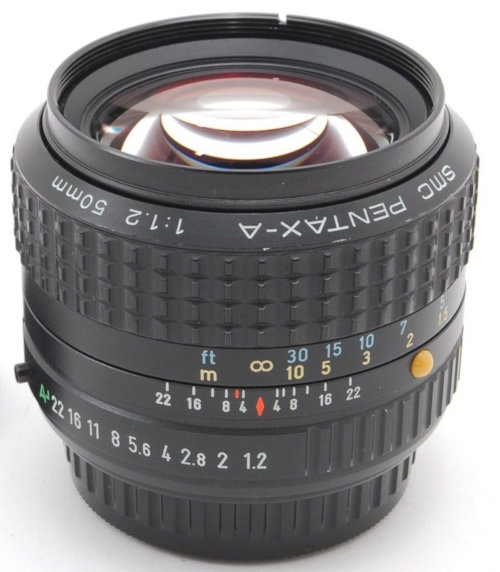
See current price and more information on:
Just like other camera brands, Pentax created a fast 50mm lens. The resulting SMC Pentax 50mm f/1.2 is a big, fast, and very expensive hunk of glass.
The lens can be difficult to get due to the fact that it will work on Pentax DSLRs so the appeal includes more than usage with 35mm film cameras. If you want to find one you’ll need to check and have a look at what is available through weeks or months.
Wide Angles
SMC Pentax-M 28mm f/2.8
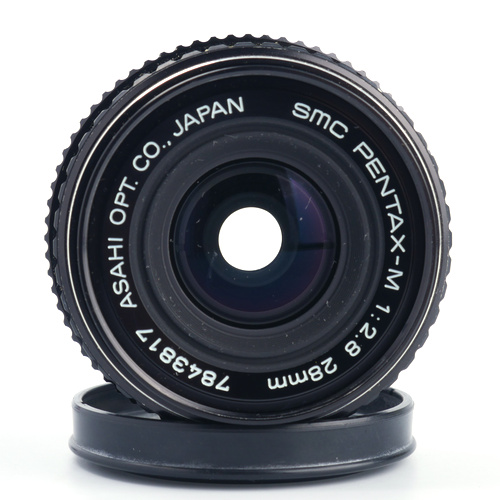
- Great combination with a 50mm lens.
- Super Multi Coating (SMC) to improve output.
- Many copies can be found.
- Relatively low cost.
See current price and more information on:
Not the best option, the SMC Pentax-M 28mm f/2.8, is still a good choice. In fact, plenty of people might not even consider it to be a wide angle lens. Then again, it is noticeably more affordable than any wider option.
There are many of wider Pentax focal lengths to consider, but they are possibly significantly more expensive or third-party choices have noticeable amounts of barrel distortion. Additionally, it is easy to see optical problems such as chromatic aberrations in third-party lenses.
More Alternatives
In terms of cost, the correlation is straightforward. The wider the field of view, the costlier the lens will likely be. Lenses with large apertures will also be higher priced.
Be aware that these do not have corrections that modern lenses have. The issue you’re most likely to see with vintage wide angles will be noticeable barrel distortion.
- SMC Pentax-M 20mm f/4
- SMC Pentax-M 28mm f/2
- SMC Pentax 18mm f/3.5
- SMC Pentax 24mm f/2.8
Portrait & Telephoto Lenses
SMC Pentax 135mm f/2.5
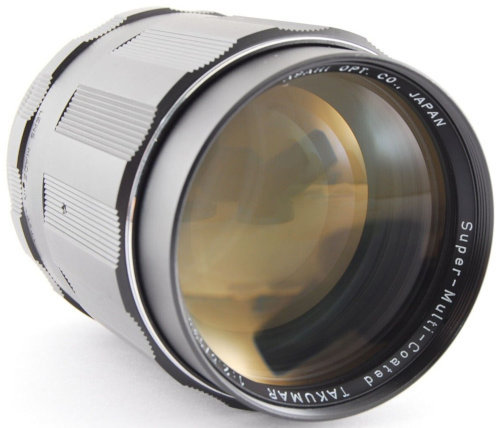
- 85mm substitute.
- Excellent value.
- Relatively inexpensive.
- Widely available.
See current price and more information on:
The 85mm focal length wasn’t as widely used as they are today compared to when the MV1 was first released in 1979. Thanks to being less expensive, 100mm and 135mm focal lengths were more commonly used.
The difference in price can be seen when checking what is available online.
More Alternatives
There are many telephoto lenses to pick from. 85mm and focal lengths longer than 135mm are going to be more expensive.
- SMC Pentax 85mm f/1.8
- SMC Pentax 85mm f/2.2 Soft
- SMC Pentax 105mm f/2.8
- SMC Pentax 120mm f/2.8
Zoom Lenses
Prior to the introduction of autofocus, in the 1980s, there were a few lenses built by third-party companies that performed better than what Pentax was offering.
Quite a few of these top performers were released under the Vivitar brand. Zooms featuring the Vivitar Series 1 branding is going to have the best optics you can expect to see from a vintage zoom.
Unfortunately, finding one of these lenses in good condition can be rather challenging. Beyond that, no vintage zooms offer exceptional performance. If you find a copy available for sale that is inexpensive enough, it could be worth purchasing.
Vivitar Series 1 28-90mm f/2.8-3.5
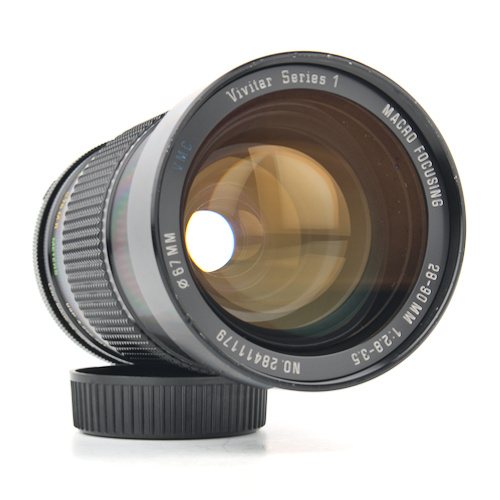
See current price and more information on:
More Options
Here are more alternatives that you can check out if you need a zoom for your MV1. None of them are going to be amazing, and you’d probably be better off purchasing a couple of primes instead.
- SMC Pentax 85-210mm f/3.5
- Vivitar Series 1 70-210mm f/3.5
- SMC Pentax 45-125mm f/4
Pentax Macro Lenses
Macro lens choices for the Pentax MV1 have availability problems. The available supply of Pentax K mount choices is limited, which increases prices higher than you would pay for comparable Canon FD mount or Nikon F mount lenses.
SMC Pentax 100mm f/4 Macro
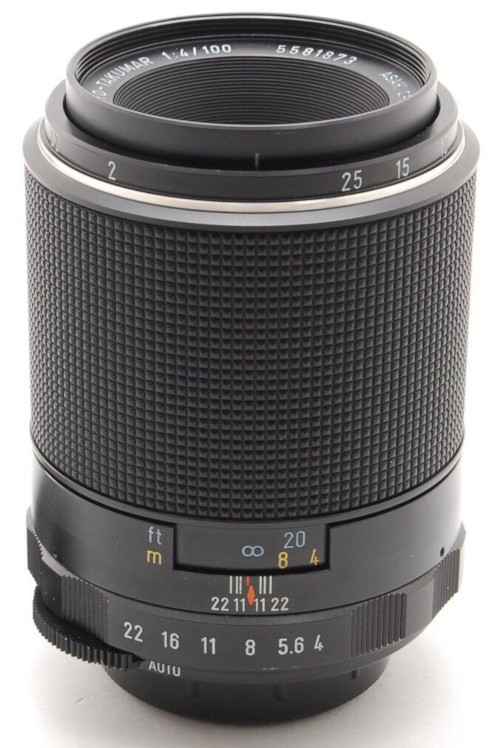
- Ideal focal length for 1x magnification.
- Widely available.
- Mediocre value.
See current price and more information on:
A few people online have experienced balsam separation of the front doublet. This is troubling because even just a little separation will expand over time and make it unusable. If you think you see this, avoid that lens and continue looking.
Vivitar 55mm f/2.8 Macro
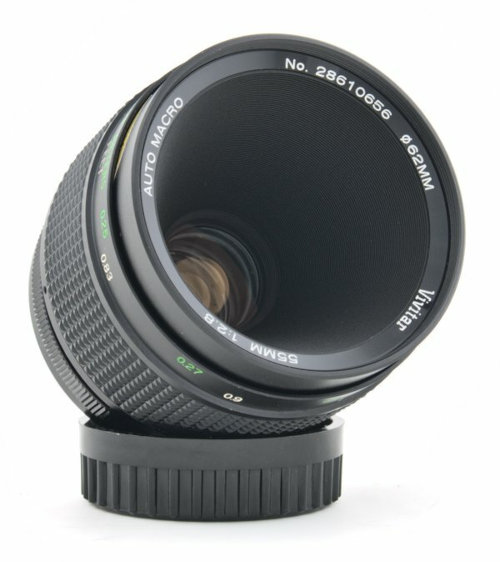
- The second best vintage macro lens I’ve used.
- An outstanding lens for close-up photography.
- Can achieve life-size magnification without needing an extension tube.
See current price and more information on:
The best vintange macro lens I’ve used, the 90mm Vivitar, was made with a variety of mounts. However, it’s challenging to find a copy with a Pentax K mount.
The Vivitar 55mm is my second favorite vintage macro lens. Keep in mind that it does have a shorter working distance when compared to the 90mm. It is an excellent choice for table top and close-up photography, but a longer focal length will be better if you would like to capture macro photos at 1:1 magnification.
Both Vivitar macros were manufactured by Komine and were released under various different brand names. If you look for one also look under the Panagor, Elicar, Quantaray, Spiratone, and Rokunar brand names.
There is a Vivitar 90mm Macro Review and a [/vivitar-55mm-f-2-8-macro-lens-review](Vivitar 55mm Macro Review).
For shooting photographs at macro magnification (1x), 90mm-105mm focal lengths will be the ideal option. You will have enough working distance to allow the use of flash, while staying away from increased weight and high costs that longer focal lengths have.
More Options
- SMC Pentax-M 50mm f/4 Macro
- Lester A Dine 105mm f/2.8 Macro Lens Review
- Vivitar 90mm f/2.8 Macro Lens Review
Used Pentax Lenses
Prices change all the time depending on supply and interest in manual focus glass. During the last few years, shooting film has expanded in popularity, which has increased prices.
Further upwards pricing pressure is produced by Pentax DSLR users buying and collecting lenses. Third party producers tend not to manufacture products for the K-mount, unlike the Canon EF or Nikon F mounts.
Marketing circumstances are continuously changing, and unforeseen changes can lead to large price movements. Even so, the relative prices between alternatives should be the same.
Taking a look at a couple of websites is a smart way to get reliable prices. If you are lucky enough to come across a fantastic deal, get it due to the fact that the best deals usually do not last very long.
